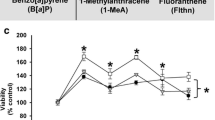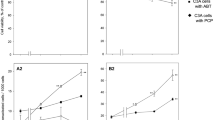Abstract
Chronic exposure to benzene has been shown to lead to bone marrow depression and the development of leukemia. The mechanism underlying the carcinogenicity of benzene is unknown, although a number of genetic changes including chromosomal aberrations have been associated with benzene toxicity. Metabolism of benzene is required for the induced toxicological effects. We have investigated the effect of trans,trans-muconaldehyde (MUC), hydroquinone (HQ), and four MUC metabolites on gap-junction intercellular communication (GJIC). Inhibition of GJIC has been considered a possible predictor of tumor promoters and non-genotoxic carcinogens, and shown to result in perturbation of hematopoiesis. MUC was found to be a strong inhibitor of GJIC (EC50=12 μmol L−1) in rat liver epithelial cells IAR20, with potency similar to that of chlordane (EC50=7 μmol L−1). HQ inhibited GJIC with an EC50 of 25 μmol L−1, and the metabolite OH/CHO with an EC50 of 58 μmol L−1. The other MUC metabolites tested, CHO/COOH and OH/COOH were weak inhibitors of GJIC whereas COOH/COOH had no effect. Benzene itself had no effect on GJIC when tested in concentrations up to 20 mmol L−1. The relative potency observed for the metabolites on GJIC is similar to their hematotoxic effects. The effect of MUC on GJIC was observed to take place concordant with a dramatic loss of connexin 43 (Cx43) from the cells as visualized by Western blotting. Substances with the ability to inhibit Cx43-dependent GJIC have previously been observed to interfere with normal hematopoietic development. The ability of benzene metabolites to interfere with gap-junction functionality, and especially the dramatic loss of Cx43 induced by MUC, should therefore be considered as a possible mechanism for benzene-induced hematotoxicity and development of leukemia.







Similar content being viewed by others
References
Amin RP, Witz G (2001) DNA-protein crosslink and DNA strand break formation in HL-60 cells treated with trans,trans-muconaldehyde, hydroquinone and their mixtures. Int J Toxicol 20:69–80
Barale R, Marrazzini A, Betti C, Vangelisti V, Loprieno N, Barrai I (1990) Genotoxicity of two metabolites of benzene: phenol and hydroquinone show strong synergistic effects in vivo. Mutat Res 244:15–20
Becker DL, Davies CS (1995) Role of gap junctions in the development of the preimplantation mouse embryo. Microsc Res Tech 31:364–374
Blaha L, Kapplova P, Vondracek J, Upham B, Machala M (2002) Inhibition of gap-junctional intercellular communication by environmentally occurring polycyclic aromatic hydrocarbons. Toxicol Sci 65:43–51
Chang RL, Wong CQ, Kline SA, Conney AH, Goldstein BD, Witz G (1994) Mutagenicity of trans,trans-muconaldehyde and its metabolites in V79 cells. Environ Mol Mutagen 24:112–115
Chang EH, Van Camp G, Smith RJ (2003) The role of connexins in human disease. Ear Hear 24:314–323
Chen H, Eastmond DA (1995) Synergistic increase in chromosomal breakage within the euchromatin induced by an interaction of the benzene metabolites phenol and hydroquinone in mice. Carcinogenesis 16:1963–1969
Dudley DT, Pang L, Decker SJ, Bridges AJ, Saltiel AR (1995) A synthetic inhibitor of the mitogen-activated protein kinase cascade. P Natl Acad Sci USA 92:7686–7689
Eastmond DA, Smith MT, Irons RD (1987) An interaction of benzene metabolites reproduces the myelotoxicity observed with benzene exposure. Toxicol Appl Pharmacol 91:85–95
Erexson GL, Wilmer JL, Steinhagen WH, Kligerman AD (1986) Induction of cytogenetic damage in rodents after short-term inhalation of benzene. Environ Mutagen 8:29–40
Evans WH, Martin PE (2002) Gap junctions: structure and function (Review). Mol Membr Biol 19:121–136
Gekeler V, Boer R, Uberall F, Ise W, Schubert C, Utz I, Hofmann J, Sanders KH, Schachtele C, Klemm K, Grunicke H (1996) Effects of the selective bisindolylmaleimide protein kinase C inhibitor GF 109203X on P-glycoprotein-mediated multidrug resistance. Br J Cancer 74:897–905
Goldstein BD (1977) Benzene toxicity: a critical evaluation: hematotoxicity in humans. J Toxicol Environ Health Suppl 2:69–105
Goldstein BD, Witz G, Javid J, Amoruso MA, Rossman T, Wolder B (1981) Muconaldehyde, a potential toxic intermediate of benzene metabolism. Adv Exp Med Biol 136(Pt A):331–339
Goodenough DA, Goliger JA, Paul DL (1996) Connexins, connexons, and intercellular communication. Annu Rev Biochem 65:475–502
Hite M, Pecharo M, Smith I, Thornton S (1980) The effect of benzene in the micronucleus test. Mutat Res 77:149–155
Hossain MZ, Jagdale AB, Ao P, Boynton AL (1999) Mitogen-activated protein kinase and phosphorylation of connexin43 are not sufficient for the disruption of gap junctional communication by platelet-derived growth factor and tetradecanoylphorbol acetate. J Cell Physiol 179:87–96
Kenne K, Fransson-Steen R, Honkasalo S, Warngard L (1994) Two inhibitors of gap junctional intercellular communication, TPA and endosulfan: different effects on phosphorylation of connexin 43 in the rat liver epithelial cell line, IAR 20. Carcinogenesis 15:1161–1165
Kline SA, Xiang Q, Goldstein BD, Witz G (1993) Reaction of (E,E)-muconaldehyde and its aldehydic metabolites, (E,E)-6-oxohexadienoic acid and (E,E)-6-hydroxyhexa-2,4-dienal, with glutathione. Chem Res Toxicol 6:578–583
Kolachana P, Subrahmanyam VV, Meyer KB, Zhang L, Smith MT (1993) Benzene and its phenolic metabolites produce oxidative DNA damage in HL60 cells in vitro and in the bone marrow in vivo. Cancer Res 53:1023–1026
Lampe PD, Lau AF (2000) Regulation of gap junctions by phosphorylation of connexins. Arch Biochem Biophys 384:205–215
Leithe E, Rivedal E (2004) Epidermal growth factor regulates ubiquitination, internalization and proteasome-dependent degradation of connexin43. J Cell Sci 117:1211–1220
Loewenstein WR, Rose B (1992) The cell-cell channel in the control of growth. Semin Cell Biol 3:59–79
Machala M, Blaha L, Vondracek J, Trosko JE, Scott J, Upham BL (2003) Inhibition of gap junctional intercellular communication by noncoplanar polychlorinated biphenyls: inhibitory potencies and screening for potential mode(s) of action. Toxicol Sci 76:102–111
Mesnil M, Montesano R, Yamasaki H (1986) Intercellular communication of transformed and non-transformed rat liver epithelial cells. Modulation by TPA. Exp Cell Res 165:391–402
Minamoto T, Mai M, Ronai Z (1999) Environmental factors as regulators and effectors of multistep carcinogenesis. Carcinogenesis 20:519–527
Mograbi B, Corcelle E, Defamie N, Samson M, Nebout M, Segretain D, Fenichel P, Pointis G (2003) Aberrant Connexin 43 endocytosis by the carcinogen lindane involves activation of the ERK/mitogen-activated protein kinase pathway. Carcinogenesis 24:1415–1423
Montecino-Rodriguez E, Dorshkind K (2001) Regulation of hematopoiesis by gap junction-mediated intercellular communication. J Leukoc Biol 70:341–347
Montecino-Rodriguez E, Leathers H, Dorshkind K (2000) Expression of connexin 43 (Cx43) is critical for normal hematopoiesis. Blood 96:917–924
Montesano R, Saint VL, Drevon C, Tomatis L (1975) Production of epithelial and mesenchymal tumours with rat liver cells transformed in vitro. Int J Cancer 16:550–558
Montesano R, Drevon C, Kuroki T, Saint VL, Handleman S, Sanford KK, DeFeo D, Weinstein IB (1977) Test for malignant transformation of rat liver cells in culture: cytology, growth in soft agar, and production of plasminogen activator. J Natl Cancer Inst 59:1651–1658
Musil LS, Cunningham BA, Edelman GM, Goodenough DA (1990) Differential phosphorylation of the gap junction protein connexin43 in junctional communication-competent and -deficient cell lines. J Cell Biol 111:2077–2088
Opsahl H, Rivedal E (2000) Quantitative determination of gap junction intercellular communication by scrape loading and image analysis. Cell Adhes Commun 7:367–375
Plappert U, Barthel E, Raddatz K, Seidel HJ (1994) Early effects of benzene exposure in mice. Hematological versus genotoxic effects. Arch Toxicol 68:284–290
Ploemacher RE, Mayen AE, de Koning AE, Krenacs T, Rosendaal M (2000) Hematopoiesis: gap junction intercellular communication is likely to be involved in regulation of stroma-dependent proliferation of hemopoietic stem cells. Hematol 5:133–147
Rivedal E, Opsahl H (2001) Role of PKC and MAP kinase in EGF- and TPA-induced connexin43 phosphorylation and inhibition of gap junction intercellular communication in rat liver epithelial cells. Carcinogenesis 22:1543–1550
Rivedal E, Yamasaki H, Sanner T (1994) Inhibition of gap junctional intercellular communication in Syrian hamster embryo cells by TPA, retinoic acid and DDT. Carcinogenesis 15:689–694
Rivedal E, Mikalsen SO, Sanner T (2000) Morphological transformation and effect on gap junction intercellular communication in Syrian hamster embryo cells as screening tests for carcinogens devoid of mutagenic activity. Toxicol In Vitro 14:185–192
Rivedal E, Myhre O, Sanner T, Eide I (2003) Supplemental role of the Ames mutation assay and gap junction intercellular communication in studies of possible carcinogenic compounds from diesel exhaust particles. Arch Toxicol 77:533–542
Robertson ML, Eastmond DA, Smith MT (1991) Two benzene metabolites, catechol and hydroquinone, produce a synergistic induction of micronuclei and toxicity in cultured human lymphocytes. Mutat Res 249:201–209
Rosenkranz M, Rosenkranz HS, Klopman G (1997) Intercellular communication, tumor promotion and non-genotoxic carcinogenesis: relationships based upon structural considerations. Mutat Res 381:171–188
Rosenkranz HS, Pollack N, Cunningham AR (2000) Exploring the relationship between the inhibition of gap junctional intercellular communication and other biological phenomena. Carcinogenesis 21:1007–1011
Ruch RJ, Fransson R, Flodstrom S, Warngard L, Klaunig JE (1990) Inhibition of hepatocyte gap junctional intercellular communication by endosulfan, chlordane and heptachlor. Carcinogenesis 11:1097–1101
Saez JC, Berthoud VM, Branes MC, Martinez AD, Beyer EC (2003) Plasma membrane channels formed by connexins: their regulation and functions. Physiol Rev 83:1359–1400
Smith MT (1996) Mechanistic studies of benzene toxicity—implications for risk assessment. Adv Exp Med Biol 387:259–266
Smith MT, Zhang L (1998) Biomarkers of leukemia risk: benzene as a model. Environ Health Perspect 106(Suppl 4):937–946
Smith MT, Yager JW, Steinmetz KL, Eastmond DA (1989) Peroxidase-dependent metabolism of benzene’s phenolic metabolites and its potential role in benzene toxicity and carcinogenicity. Environ Health Perspect 82:23–29
Snyder R (2002) Benzene and leukemia. Crit Rev Toxicol 32:155–210
Snyder R, Dimitriadis E, Guy R, Hu P, Cooper K, Bauer H, Witz G, Goldstein BD (1989) Studies on the mechanism of benzene toxicity. Environ Health Perspect 82:31–35
Swierenga SH, Yamasaki H, Piccoli C, Robertson L, Bourgon L, Marceau N, Fitzgerald DJ (1990) Effects on intercellular communication in human keratinocytes and liver-derived cells of polychlorinated biphenyl congeners with differing in vivo promotion activities. Carcinogenesis 11:921–926
Tennant RW, Ashby J (1991) Classification according to chemical structure, mutagenicity to Salmonella and level of carcinogenicity of a further 39 chemicals tested for carcinogenicity by the U.S. National Toxicology Program. Mutat Res 257:209–227
Tice RR, Costa DL, Drew RT (1980) Cytogenetic effects of inhaled benzene in murine bone marrow: induction of sister chromatid exchanges, chromosomal aberrations, and cellular proliferation inhibition in DBA/2 mice. P Natl Acad Sci USA 77:2148–2152
Tough IM, Brown WM (1965) Chromosome aberrations and exposure to ambient benzene. Lancet 10:684–685
Tunek A, Platt KL, Przybylski M, Oesch F (1980) Multi-step metabolic activation of benzene. Effect of superoxide dismutase on covalent binding to microsomal macromolecules, and identification of glutathione conjugates using high pressure liquid chromatography and field desorption mass spectrometry. Chem Biol Interact 33:1–17
Upham BL, Weis LM, Trosko JE (1998) Modulated gap junctional intercellular communication as a biomarker of PAH epigenetic toxicity: structure–function relationship. Environ Health Perspect 106(Suppl 4):975–981
Vigliani EC, Forni A (1976) Benzene and leukemia. Environ Res 11:122–127
Witz G, Rao GS, Goldstein BD (1985) Short-term toxicity of trans,trans-muconaldehyde. Toxicol Appl Pharmacol 80:511–516
Yamasaki H and Naus CC (1996) Role of connexin genes in growth control. Carcinogenesis 17:1199–1213
Yamasaki H, Ashby J, Bignami M, Jongen W, Linnainmaa K, Newbold RF, Nguyen-Ba G, Parodi S, Rivedal E, Schiffmann D, Simons JW, Vasseur P (1996) Nongenotoxic carcinogens: development of detection methods based on mechanisms: a European project. Mutat Res 353:47–63
Zhang Z, Kline SA, Kirley TA, Goldstein BD, Witz G (1993) Pathways of trans,trans-muconaldehyde metabolism in mouse liver cytosol: reversibility of monoreductive metabolism and formation of end products. Arch Toxicol 67:461–467
Zhang L, Rothman N, Wang Y, Hayes RB, Li G, Dosemeci M, Yin S, Kolachana P, Titenko-Holland N, Smith MT (1998a) Increased aneusomy and long arm deletion of chromosomes 5 and 7 in the lymphocytes of Chinese workers exposed to benzene. Carcinogenesis 19:1955–1961
Zhang L, Wang Y, Shang N, Smith MT (1998b) Benzene metabolites induce the loss and long arm deletion of chromosomes 5 and 7 in human lymphocytes. Leuk Res 22:105–113
Acknowledgements
The authors are grateful to Astri Nordahl and Randi Skibakk for excellent technical assistance. The work is supported by the Norwegian Cancer Society.
Author information
Authors and Affiliations
Corresponding author
Rights and permissions
About this article
Cite this article
Rivedal, E., Witz, G. Metabolites of benzene are potent inhibitors of gap-junction intercellular communication. Arch Toxicol 79, 303–311 (2005). https://doi.org/10.1007/s00204-004-0638-0
Received:
Accepted:
Published:
Issue Date:
DOI: https://doi.org/10.1007/s00204-004-0638-0




